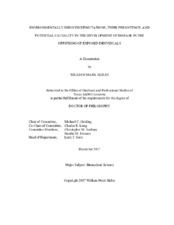| dc.description.abstract | In recent years, there has been increased interest into better understanding how environmental In recent years, there has been increased interest into better understanding how
environmental exposures influence the long-term health of an organism. Chemical
pollutants, dietary deficiencies, embryonic stress and multiple other external factors have
all demonstrated long-lasting effects upon development, metabolism, and health even after
transient exposures. The mechanisms by which these exposures can impact development
far beyond the period of exposure remain largely unknown. To gain better insight into the
developmental origins of both birth defects and disease, we must better understand how
environmental exposures alter development.
In this work, we will examine the capacity of the environment to impact chromatin
states, and then determine whether these changes are heritable; and are thus potentially
causal in the development of disease. This is an important question due to the recent
recognition that aberrant chromatin states can lead to pathological patterns of gene
expression, a circumstance commonly referred to as “epimutations”. Dysregulation of
gene expression patterns during development have been shown to cause a multitude of
irregular phenotypes in offspring and lifelong disorders in mature organisms. This altered
chromatin state, coined an epimutation by Dr. Emma Whitelaw, is important due to the
mutation not being in the genetic code itself, but in the way DNA regulatory regions are
packaged within the chromatin template, and thus accessed by the protein factors directing
gene transcription. The body of work presented here will examine the ability of common
environmental exposures to modulate chromatin structure. We will examine these changes over time in an effort to better understand the inheritance of epigenetic change. Secondly,
we will measure whether environmentally induced alterations in chromatin structure
within the germline persist, and are heritable. These questions are all relevant to better
understanding the developmental origins of disease. | en |


